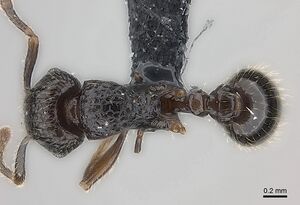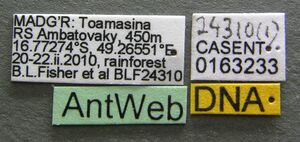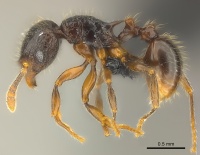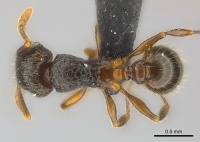Tetramorium ambatovy
| Tetramorium ambatovy | |
|---|---|

| |
| Scientific classification | |
| Kingdom: | Animalia |
| Phylum: | Arthropoda |
| Class: | Insecta |
| Order: | Hymenoptera |
| Family: | Formicidae |
| Subfamily: | Myrmicinae |
| Tribe: | Crematogastrini |
| Genus: | Tetramorium |
| Species: | T. ambatovy |
| Binomial name | |
| Tetramorium ambatovy Hita Garcia & Fisher, 2012 | |
The species appears to prefer montane or lowland rainforests at elevations from 140 to 1088 m, and was always collected from the leaf litter stratum.
Identification
A member of the Tetramorium dysalum-species group
Within its species group T. ambatovy can be easily differentiated from the other group members due to the fine and irregular rugulae on its mesosomal dorsum, which is never longitudinally organised, and the comparatively large eyes (OI 25 - 26). (Hita Garcia and Fisher 2012)
Keys including this Species
Distribution
The distribution of T. ambatovy is somewhat disjunctive. Most specimens are known from a strip that extends from the area around Ambatovy, Andasibe-Mantadia, and Torotorofotsy to Sahafina and then north to Ambatovaky, but one specimen was also collected from Andohahela in the southwest. (Hita Garcia and Fisher 2012)
Latitudinal Distribution Pattern
Latitudinal Range: -16.77274° to -24.7585°.
| North Temperate |
North Subtropical |
Tropical | South Subtropical |
South Temperate |
- Source: AntMaps
Distribution based on Regional Taxon Lists
Malagasy Region: Madagascar (type locality).
Distribution based on AntMaps
Distribution based on AntWeb specimens
Check data from AntWeb
Countries Occupied
| Number of countries occupied by this species based on AntWiki Regional Taxon Lists. In general, fewer countries occupied indicates a narrower range, while more countries indicates a more widespread species. |

|
Estimated Abundance
| Relative abundance based on number of AntMaps records per species (this species within the purple bar). Fewer records (to the left) indicates a less abundant/encountered species while more records (to the right) indicates more abundant/encountered species. |

|
Biology
Castes
Images from AntWeb
   
| |
| Queen (alate/dealate). Specimen code casent0117452. Photographer Estella Ortega, uploaded by California Academy of Sciences. | Owned by CAS, San Francisco, CA, USA. |
   
| |
| Holotype of Tetramorium ambatovy. Worker. Specimen code casent0124721. Photographer Will Ericson, uploaded by California Academy of Sciences. | Owned by CAS, San Francisco, CA, USA. |
   
| |
| Worker. Specimen code casent0163233. Photographer Shannon Hartman, uploaded by California Academy of Sciences. | Owned by CAS, San Francisco, CA, USA. |
Nomenclature
The following information is derived from Barry Bolton's Online Catalogue of the Ants of the World.
- ambatovy. Tetramorium ambatovy Hita Garcia & Fisher, 2012: 60, figs. 69, 92-94 (w.) MADAGASCAR.
Unless otherwise noted the text for the remainder of this section is reported from the publication that includes the original description.
Description
Worker
HL 0.66 - 0.72 (0.69); HW 0.65 - 0.71 (0.68); SL 0.48 - 0.52 (0.50); EL 0.17 - 0.18 (0.17); PH 0.32 - 0.38 (0.34); PW 0.47 - 0.52 (0.49); WL 0.80 - 0.87 (0.83); PSL 0.19 - 0.23 (0.21); PTL 0.11 - 0.13 (0.12); PTH 0.27 - 0.29 (0.28); PTW 0.20 - 0.23 (0.22); PPL 0.21 - 0.23 (0.22); PPH 0.26 - 0.28 (0.27); PPW 0.32 - 0.35 (0.33); CI 97 - 99 (98); SI 72 - 76 (74); OI 25 - 26 (26); DMI 58 - 61 (59); LMI 40 - 44 (41); PSLI 28 - 32 (30); PeNI 41 - 45 (44); LPeI 40 - 45 (43); DPeI 174 - 195 (181); PpNI 63 - 69 (67); LPpI 79 - 85 (82); DPpI 145 - 155 (150); PPI 148 - 163 (153) (12 measured).
Head weakly longer than wide (CI 97 - 99). Anterior clypeal margin with distinct median impression. Frontal carinae well-developed, ending at or shortly before posterior head margin. Antennal scrobes faint and shallow. Antennal scapes short, not reaching posterior head margin (SI 72 - 76). Eyes comparatively large (OI 25 - 26). Mesosomal outline in profile flat to weakly convex, weak to moderate margination from lateral to dorsal mesosoma; promesonotal suture and metanotal groove absent; mesosoma comparatively high, compact, and stout (LMI 40 - 44). Propodeal spines long, spinose, and acute (PSLI 28 - 32); propodeal lobes small and triangular. Petiolar node in profile squamiform, approximately 2.2 to 2.5 times higher than long (LPeI 40 - 45), anterior and posterior faces approximately parallel, anterodorsal and posterodorsal angles at about same height, dorsum not tapering backwards posteriorly; node in dorsal view 1.7. to 2 times longer than wide (DPeI 174 - 195). Postpetiole in profile rounded, approximately 1.2 times higher than long (LPpI 79 - 85), in dorsal view between 1.4 to 1.5 times wider than long (DPpI 145 - 155). Postpetiole in profile appearing a bit more voluminous than petiolar node, in dorsal view approximately 1.5 to 1.6 times wider than petiolar node (PPI 148 - 163). Mandibles longitudinally rugose or rugulose; clypeus distinctly striate, sometimes irregularly arranged; cephalic dorsum between frontal carinae reticulate-rugose but with including a portion with more pronounced longitudinal rugosity; lateral and ventral head reticulate-rugose. Ground sculpture on head often faint, sometimes moderately developed reticulate-punctate. Lateral mesosoma partly with irregular rugulae, partly completely unsculptured; dorsal mesosoma with fine and irregular rugulae; ground sculpture faint to absent. Both segments generally unsculptured, smooth, and shiny, postpetiole sometimes laterally with weak sculpture. All dorsal surfaces of body with abundant, long, erect pilosity. Body of uniform brownish colour, appendages often of lighter colour.
Type Material
Holotype worker, MADAGASCAR, Toamasina, Ambatovy, 12.4 km NE Moramanga, 18.84963 S, 48.2947 E, 1010 m, montane rainforest, sifted litter (leaf mold, rotten wood), collection code BLF16914, 3.-6.III.2007 (B.L. Fisher et al.) (California Academy of Sciences: CASENT0124721). Paratypes, six workers with same data as holotype (BMNH: CASENT0124748; CASC: CASENT: CASENT0124729; CASENT0124730; CASENT0124737; CASENT0124759; Musee d'Histoire Naturelle Genève: CASENT0124741); and four workers with same data as holotype except collected from pitfall trap and collection code BLF16915 (CASC: CASENT0122307; CASENT0123371; CASENT0114807; Museum of Comparative Zoology: CASENT0122306).
Etymology
The name of the new species refers to the type locality. The species epithet is a noun in apposition and thus invariant.
References
References based on Global Ant Biodiversity Informatics
- Garcia H. F. and B. L. Fisher. 2012. The ant genus Tetramorium Mayr (Hymenoptera: Formicidae) in the Malagasy regiontaxonomy of the T. bessonii, T. bonibony, T. dysalum, T. marginatum, T. tsingy, and T. weitzeckeri species groups. Zootaxa 3365: 1-123

